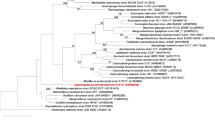Abstract
A cinnamate-fermenting bacterium (strain PeC1) was isolated in pure culture from anoxic sludge of an oil refinery wastewater treatment facility. It was a mesophilic gram-negative non-sporing actively motile rod. It did not reduce nitrate, sulfte, or other sulfur compounds as electron acceptors. It fermented cinnamate to 3-phenylpropionate, benzoate, and acetate; crotonate to butyrate and acetate; pyruvate to lactate and acetate; acetoin to ethanol and acetate; and carbohydrates to ethanol, formate, and acetate. The DNA base ratio of the strain was 44 mol% guanine plus cytosine. It is described as a new species of the genus Acetivibrio, A. multivorans sp. nov.
Similar content being viewed by others
References
BryantMP (1972) Commentary on Hungate technique for culture of anaerobic bacteria. Am J Clin Nutr 25:1324–1328
CataldoDA, HaroonM, SchraderLE, YoungVL (1975) Rapid colorimetric determination of nitrate in plant tissue by nitration of salicylic acid. Commun Soil Sci Plant Anal 6:71–80
ClineE (1969) Spectrophotometric determination of hydrogensulfide in natural waters. Limnol Oceanogr 14:454–458
DehningI, SchinkB (1989) Malonomonas rubra gen. nov. sp. nov., a microaerotolerant anaerobic bacterium growing by decarboxylation of malonate. Arch Microbiol 151:427–433
DeWeerdKM, MandelcoL, TannerRS, WoeseCR, SuflitaJM (1990) Desulfomonile tiedjei gen. nov. and sp. nov., a novel anaerobic, dehalogenating, sulfate-reducing bacterium. Arch Microbiol 154:23–30
ElsdenSR, HiltonMG, WallerJM (1976) The end products of the metabolism of aromatic amino acids by clostridia. Arch Microbiol 107:283–288
HoskinsJK (1934) Most probable numbers for evaluation of coliaerogenes tests by fermentation tube method. Public Health Rep Washington 49:393–405
KlempsR, CypionkaH, WiddelF, PfennigN (1985) Growth with hydrogen, and further physiological characteristics of Desulfotomaculum species. Arch Microbiol 143:203–208
MadiganMT, GestH (1988) Selective enrichment and isolation of Rhodopseudomonas palustris using trans-cnnamic acid as sole carbon source. FEMS Microbiol Ecol 43:53–58
MageeCM, RodeheaverG, EdgertonRF (1975) A more reliable Gram staining technique for diagnosis of surgical infections. Am J Surg 130:341–346
MossCW, LambertMA, GoldsmithDJ (1970) Production of hydrocinnamic acid by clostridia. Appl Microbiol 19:375–378
PatelGB, KhanAW, AgnewBJ, ColvinJR (1980) Isolation and characterization of an anaerobic, cellulolytic microorganism, Acetivibrio cellulolyticus gen. nov., sp. nov. Int J Syst Bacteriol 30:179–185
PfennigN (1978) Rhodococcus purpureus gen. nov. and sp. nov., a ringshaped vitamin B12-requiring member of the family Rhodospirillaceae. Int J Syst Bacteriol 28:283–288
RobinsonLM, RitchieAE (1981) Emendation of Acetivibrio and description of Acetivibrio ethanolgignens, a new species from the colons of pigs with dysentery. Int J Syst Bacteriol 31:333–338
SchinkB, StiebM (1983) Fermentative degradation of polyethylene glycol by a strictly anaerobic, Gram-negative, nonsporeforming bacterium, Pelobacter venetianus sp. nov. Appl Environ Microbiol 45:1905–1913
SeitzH-J, CypionkaH (1986) Chemolithotrophic growth of Desulfovibrio desulfuricans with hydrogen coupled to ammonification of nitrate or nitrite. Arch Microbiol 146:63–67
StiebM, SchinkB (1984) A new 3-hydroxybutyrate fermenting anaerobe, Ilyobacter polytropus, gen. nov. sp. nov., possessing various fermentation pathways. Arch Microbiol 140:139–146
TamaokaJ, KomagataK (1984) Determination of DNA base composition by reversed-phase high-performance liquid chromatography. FEMS Microbiol Lett 25:125–128
TanakaK, PfennigN (1988) Fermentation of 2-methoxyethanol by Acetobacterium malicum sp. nov. and Pelobacter venetianus. Arch Microbiol 149:181–187
TanakaK, NakamuraK, MikamiE (1990) Fermentation of maleate by a gram-negative strictly anaerobic non-spore-former, Propionivibrio dicarboxylicus gen. nov., sp. nov. Arch Microbiol 154:323–328
TschechA, PfennigN (1984) Growth yield increase linked to caffeate reduction in Acetobacterium woodii. Arch Microbiol 137:163–167
WiddelF, PfennigN (1981) Studies on dissimilatory sulfate-reducing bacteria that decompose fatty acids. I. Isolation of new sulfate-reducing bacteria enriched with acetate from saline environments. Description of Desulfobacter postgatei gen. nov., sp. nov. Arch Microbiol 129:395–400
Author information
Authors and Affiliations
Rights and permissions
About this article
Cite this article
Tanaka, K., Nakamura, K. & Mikami, E. Fermentation of cinnamate by a mesophilic strict anaerobe, Acetivibrio multivorans sp. nov.. Arch. Microbiol. 155, 120–124 (1991). https://doi.org/10.1007/BF00248604
Received:
Accepted:
Published:
Issue Date:
DOI: https://doi.org/10.1007/BF00248604




